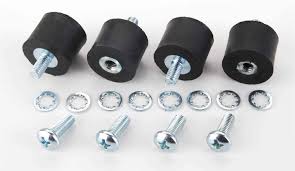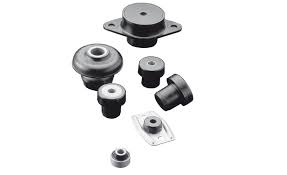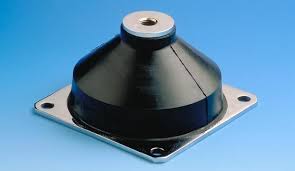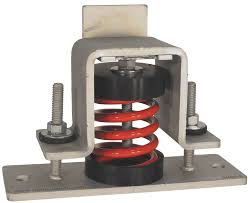Seismic isolation bearings have played a crucial role in reducing the impact of earthquakes on buildings and infrastructure. In recent years, advancements in seismic isolation bearings technology have led to significant improvements in their performance and efficiency. This has resulted in a greater level of protection for structures in seismic-prone areas. This article will provide an overview of the latest developments in seismic isolation bearings technology and their potential impact on the field of earthquake engineering.
Seismic isolation bearings technology has advanced significantly in recent years. These bearings are specifically designed to absorb and dissipate the energy generated by seismic activity, thus reducing the impact on structures and infrastructure. Advancements in materials science and engineering have led to the development of more durable and effective seismic isolation bearings. New materials, such as high damping rubber and lead cores, have been incorporated into these bearing systems to enhance their performance and longevity. In addition, modern seismic isolation bearings are now equipped with advanced monitoring and control systems that can automatically adjust the bearing's properties in response to changing seismic conditions. This level of adaptability and intelligence allows for greater protection of structures during earthquakes. Furthermore, research and development in the field of seismic isolation bearings have led to the creation of innovative designs that are more efficient and cost-effective, making this technology more accessible for a wider range of construction projects. Overall, these advancements in seismic isolation bearings technology have significantly improved the resilience and safety of structures in earthquake-prone areas, ultimately contributing to the overall disaster preparedness and mitigation efforts.
Seismic isolation bearings technology has seen significant advancements in recent years, primarily due to developments in materials science and engineering. New materials such as high damping rubber and lead cores have been incorporated into these bearing systems to enhance their performance and durability. Additionally, modern seismic isolation bearings are now equipped with advanced monitoring and control systems that can automatically adjust the bearing's properties in response to changing seismic conditions, making them more adaptable and intelligent. Furthermore, research and development in the field of seismic isolation bearings have led to the creation of more efficient and cost-effective designs, making this technology more accessible for a wider range of construction projects. These advancements have significantly improved the resilience and safety of structures in earthquake-prone areas and contributed to overall disaster preparedness and mitigation efforts.
Understanding Seismic Isolation Bearings: A Structural Engineering Solution

Understanding Seismic Isolation Bearings: A Structural Engineering Solution is a comprehensive guide that explores the use of seismic isolation bearings as a solution for mitigating the impact of earthquakes on structures. The book delves into the principles of seismic isolation, the different types of isolation bearings, their design and installation, and their effectiveness in protecting buildings and infrastructure from seismic forces. It also covers case studies and real-world examples to demonstrate the practical application of seismic isolation bearings in structural engineering. This resource is essential for engineers, architects, and anyone involved in designing, constructing, or retrofitting buildings in seismically active areas.
Advantages and Disadvantages of Seismic Isolation Bearings in Building Design

Advantages of using seismic isolation bearings in building design include: 1. Protection against seismic forces: Seismic isolation bearings can help protect buildings from damage during an earthquake by absorbing and dissipating seismic forces, thereby reducing the risk of structural damage. 2. Improves building performance: By reducing the impact of seismic forces, seismic isolation bearings can help improve the overall performance of a building during an earthquake, potentially minimizing repair costs and downtime. 3. Enhanced safety: Buildings equipped with seismic isolation bearings are generally safer for occupants during seismic events, as they are less likely to experience severe structural damage or collapse. Disadvantages of seismic isolation bearings in building design include: 1. Cost: The installation of seismic isolation bearings can significantly increase the initial construction costs of a building, making it a less appealing option for some developers and builders. 2. Maintenance: Seismic isolation bearings require regular maintenance and inspections to ensure they remain in optimal working condition. This can add to the overall cost of building ownership and operation. 3. Limited applicability: Seismic isolation bearings may not be suitable for all types of building designs or structures, limiting their potential use in certain construction projects.
The Role of Seismic Isolation Bearings in Mitigating Structural Damage

Seismic isolation bearings are a key component in mitigating structural damage during an earthquake. These bearings are designed to absorb and dissipate the energy generated by seismic activity, thus reducing the impact on the structure. By isolating the building from the ground motion, seismic isolation bearings can effectively limit the amount of damage sustained by the structure. This is particularly important in areas prone to earthquakes, where the use of seismic isolation bearings can greatly enhance the structural resilience of buildings and critical infrastructure. In essence, seismic isolation bearings play a critical role in safeguarding structures and ensuring the safety of occupants during seismic events.
Case Studies on the Effectiveness of Seismic Isolation Bearings in Earthquake-Prone Regions
vibration isolation systems

One case study on the effectiveness of seismic isolation bearings in earthquake-prone regions was conducted in Japan, where numerous buildings with seismic isolation technology were able to withstand significant earthquakes with minimal damage. Another study in New Zealand found that buildings equipped with seismic isolation bearings performed better during earthquakes compared to traditional structures. Additionally, a case study in California showed that buildings retrofitted with seismic isolation bearings experienced reduced damage during seismic events. These case studies demonstrate the effectiveness of seismic isolation bearings in enhancing the resilience of structures in earthquake-prone regions.
Design Considerations for Implementing Seismic Isolation Bearings in Building Projects
Design considerations for implementing seismic isolation bearings in building projects include: 1. Understanding the local seismic activity and ground conditions to determine the appropriate level of isolation required. 2. Selecting the most suitable type of seismic isolation bearings based on the building's structural design, load requirements, and performance objectives. 3. Ensuring proper integration of the seismic isolation system with the building's overall structural design to optimize its performance during seismic events. 4. Considering the impact of seismic isolation bearings on the building's architectural and functional requirements, including potential changes to the floor heights, façade systems, and mechanical/electrical installations. 5. Collaborating with experienced engineers, architects, and construction professionals to ensure that the seismic isolation system is properly integrated into the building's design and construction process. 6. Incorporating long-term maintenance and monitoring plans to ensure the ongoing performance and safety of the seismic isolation system. 7. Complying with relevant building codes, standards, and regulations related to seismic design and construction to ensure the safety and resilience of the building.
The Importance of Proper Maintenance and Inspection of Seismic Isolation Bearings
Seismic isolation bearings are critical components in protecting buildings and infrastructure from the damaging effects of earthquakes. Proper maintenance and inspection of these bearings are essential to ensure their effectiveness in reducing the impact of seismic activity. Regular inspections can help to identify any signs of wear, damage, or malfunction in the isolation bearings. This allows for timely repairs or replacements to be carried out, preventing the potential failure of the bearings during an earthquake. Additionally, proper maintenance can prolong the lifespan of the bearings, saving costs in the long run. Furthermore, regular maintenance and inspection of seismic isolation bearings are necessary to comply with building codes and regulations. Non-compliance can result in serious consequences, including safety hazards and legal liabilities. In conclusion, the importance of proper maintenance and inspection of seismic isolation bearings cannot be overstated. It is essential for the safety and integrity of buildings and infrastructure in earthquake-prone areas.
Innovations in Seismic Isolation Bearings: Enhancing Building Resilience
Innovations in seismic isolation bearings involve the development of advanced materials and designs to enhance the resilience of buildings during earthquakes. These bearings are engineered to absorb and dissipate the energy generated by seismic waves, thus reducing the impact on the structure and its occupants. By incorporating these innovations into building design, engineers can better protect infrastructure and improve overall safety in earthquake-prone regions. Additionally, ongoing research and development in this field continue to drive improvements in seismic isolation technology, further increasing the effectiveness of these systems.
The Future of Seismic Isolation Bearings: Advancements in Technology and Research
hvac vibration isolators residential
The future of seismic isolation bearings is a topic of great interest in the field of earthquake engineering. Advancements in technology and research are aimed at improving the performance and efficiency of these bearings in protecting structures from seismic forces. One of the key areas of focus is the development of new materials and manufacturing processes that can enhance the durability and reliability of seismic isolation bearings. Researchers are also investigating novel designs and configurations to optimize the performance of these bearings under various seismic conditions. Furthermore, advancements in monitoring and control systems are being integrated into seismic isolation bearings to enable real-time adjustment and adaptability to different seismic events. This can potentially improve the overall effectiveness of these bearings in safeguarding structures and minimizing damage during earthquakes. Additionally, research efforts are also exploring the potential use of advanced computational modeling and simulation techniques to better understand the behavior of seismic isolation bearings and optimize their design for improved performance. Overall, the future of seismic isolation bearings is characterized by ongoing technological innovations and research endeavors aimed at enhancing their capabilities in protecting structures from the damaging effects of earthquakes.
In conclusion, the advancements in seismic isolation bearings technology have proven to be a groundbreaking development in the field of earthquake engineering. These innovative bearings provide a critical solution for improving the resilience of structures against seismic events, offering a more effective and reliable method for preventing catastrophic damage. As seismic isolation bearings continue to evolve, they hold great promise for revolutionizing the way we approach earthquake-resistant design and construction.
See also
https://www.avmounts.co.uk/ https://www.lord.com/products-and-solutions/vibration-mounts